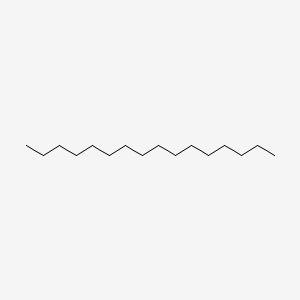| MeSH term | MeSH ID | Detail |
|---|---|---|
| Body Weight | D001835 | 333 associated lipids |
| Coronary Disease | D003327 | 70 associated lipids |
| Encephalomyelitis, Autoimmune, Experimental | D004681 | 26 associated lipids |
| Glomerulonephritis | D005921 | 35 associated lipids |
| Hyperplasia | D006965 | 34 associated lipids |
| Keratosis | D007642 | 9 associated lipids |
| Lupus Erythematosus, Systemic | D008180 | 43 associated lipids |
| Peritonitis | D010538 | 38 associated lipids |
| Serratia Infections | D016868 | 2 associated lipids |
Hexadecane
Hexadecane is a lipid of Fatty Acyls (FA) class. The involved functions are known as Analyte. The related lipids are Fatty Acids and palmitoleic acid.
Cross Reference
Introduction
To understand associated biological information of Hexadecane, we collected biological information of abnormalities, associated pathways, cellular/molecular locations, biological functions, related genes/proteins, lipids and common seen animal/experimental models with organized paragraphs from literatures.
What diseases are associated with Hexadecane?
There are no associated biomedical information in the current reference collection.
Possible diseases from mapped MeSH terms on references
We collected disease MeSH terms mapped to the references associated with Hexadecane
PubChem Associated disorders and diseases
What pathways are associated with Hexadecane
There are no associated biomedical information in the current reference collection.
PubChem Biomolecular Interactions and Pathways
Link to PubChem Biomolecular Interactions and PathwaysWhat cellular locations are associated with Hexadecane?
There are no associated biomedical information in the current reference collection.
What functions are associated with Hexadecane?
Related references are published most in these journals:
| Function | Cross reference | Weighted score | Related literatures |
|---|
What lipids are associated with Hexadecane?
Related references are published most in these journals:
| Lipid concept | Cross reference | Weighted score | Related literatures |
|---|
What genes are associated with Hexadecane?
There are no associated biomedical information in the current reference collection.
What common seen animal models are associated with Hexadecane?
There are no associated biomedical information in the current reference collection.
NCBI Entrez Crosslinks
All references with Hexadecane
Download all related citations| Authors | Title | Published | Journal | PubMed Link |
|---|---|---|---|---|
| Thomas-Hall SR et al. | Cold-adapted yeasts from Antarctica and the Italian Alps-description of three novel species: Mrakia robertii sp. nov., Mrakia blollopis sp. nov. and Mrakiella niccombsii sp. nov. | 2010 | Extremophiles | pmid:19898737 |
| Ferguson AL et al. | Systematic determination of order parameters for chain dynamics using diffusion maps. | 2010 | Proc. Natl. Acad. Sci. U.S.A. | pmid:20643962 |
| Maisonnasse A et al. | New insights into honey bee (Apis mellifera) pheromone communication. Is the queen mandibular pheromone alone in colony regulation? | 2010 | Front. Zool. | pmid:20565874 |
| Kang YS and Park W | Contribution of quorum-sensing system to hexadecane degradation and biofilm formation in Acinetobacter sp. strain DR1. | 2010 | J. Appl. Microbiol. | pmid:20629796 |
| Partovinia A et al. | Carbon content reduction in a model reluctant clayey soil: slurry phase n-hexadecane bioremediation. | 2010 | J. Hazard. Mater. | pmid:20570040 |
| Hua X et al. | Degradation of hexadecane by Enterobacter cloacae strain TU that secretes an exopolysaccharide as a bioemulsifier. | 2010 | Chemosphere | pmid:20537678 |
| Abdel-Mottaleb MM et al. | In vitro drug release mechanism from lipid nanocapsules (LNC). | 2010 | Int J Pharm | pmid:20149853 |
| Pyroh TP et al. | [Peculiarities of surface-active trehalose mycolates synthesis of Rhodococcus erythropolis EK-1]. | 2010 Mar-Apr | Mikrobiol. Z. | pmid:20455436 |
| Yeom SH et al. | A strategic approach for the design and operation of two-phase partitioning bioscrubbers for the treatment of volatile organic compounds. | 2010 Nov-Dec | Biotechnol. Prog. | pmid:20718037 |
| El'kin AA et al. | [Oxidative biotransformation of thioanisole by Rhodococcus rhodochrous IEGM 66 cells]. | 2010 Nov-Dec | Prikl. Biokhim. Mikrobiol. | pmid:21261073 |
